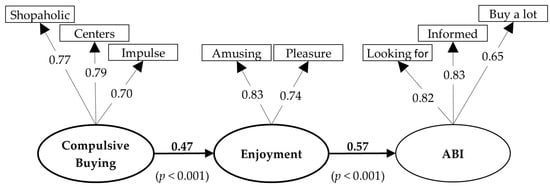Abstract
In view of concerns about consumers’ vulnerability to contemporary marketing tactics, this study aims to examine the extent to which compulsive buying affects beliefs about digital advertising. The results of a survey of 117 consumers suggest that compulsive buying positively affects the enjoyment of digital advertising. Subsequently, enjoyment positively affects the perceived appropriateness and behavioral impact of digital advertising. Overall, the findings indicate that a ‘shopaholic’ market segment appears to be more positively predisposed and therefore receptive to digital advertising. Thus, socially responsible businesses should take into account compulsive buyers’ vulnerability and protect them by adjusting their advertising actions accordingly.
1. Objectives
Most prior studies have perceived compulsive buying as a consequence of advertising [1]. However, considering that such tendencies or behaviors may be the function of numerous external influences and personal characteristics [2], the present research views compulsive buying as a factor shaping consumer beliefs about digital advertising [3], and aims to examine the significance and magnitude of its impact.
2. Methodology
The study’s non-random sample consisted of 117 participants, the majority of whom were female (73%), had attended tertiary education (68%), and were between 18–34 years of age (68%). Compulsive buying was measured with a 6-item scale [4], while beliefs about digital advertising were measured with a slightly modified and shorter version of the ‘public opinion towards advertising’ scale [5].
3. Results
Exploratory and confirmatory factor analyses established one factor that measured ‘Compulsive Buying-CB’ (α = 0.79) and two factors that measured consumer beliefs about digital advertising (α = 0.81 for ‘Appropriateness and Behavioral Impact-ABI’ and Spearman–Brown = 0.76 for ‘Enjoyment’). The structural equation model (x2 = 20.18, p = 0.32; CFI = 0.99; TLI = 0.99; RMSEA = 0.03; SRMR = 0.05) shows the significant and positive effects of CB on enjoyment and the effects of enjoyment on ABI (Figure 1).

Figure 1.
Path diagram.
4. Implications
A ‘shopaholic’ market segment appears more receptive to digital advertising, as its members are more likely to believe that digital ads are entertaining and engaging (i.e., enjoyable). Nevertheless, brands are advised to abstain from solely viewing this market segment as a profit-making opportunity. Because of the effectiveness of contemporary marketing tactics, socially responsible businesses should consider compulsive buyers’ vulnerability and adjust their advertising actions accordingly.
5. Originality Value
Contrary to an existing theory suggesting that compulsive buying may, in part, be the product of marketing and advertising tactics [6], the present study suggests that, when viewed as a consumer characteristic, compulsive buying shapes consumers’ beliefs about digital advertising. To the best of our knowledge, this work represents one of the few research efforts to establish a directional relationship with compulsive buying as the explanatory variable.
6. Contribution
In contrast to past research, which hypothesized that audiences with compulsive buying tendencies would have unfavorable attitudes towards advertising (Aad) [3], the present research indicates that compulsive buying is positively associated with the enjoyment of digital advertising. Furthermore, results agree with more up-to-date research about consumer materialism, which has been found to positively affect Aad [7].
Author Contributions
Conceptualization, C.L. and A.P.; methodology, C.L.; software, C.L.; validation, C.L., A.P. and N.K.; formal analysis, C.L.; investigation, A.P.; resources, A.P.; data curation, C.L.; writing—original draft preparation, C.L. and A.P.; writing—review and editing, C.L., A.P. and N.K.; visualization, C.L. and A.P.; supervision, C.L.; project administration, C.L., A.P. and N.K. All authors have read and agreed to the published version of the manuscript.
Funding
This research received no external funding.
Institutional Review Board Statement
Ethical review and approval were waived for this survey study because it was designed and conducted in accordance with GDPR (Regulation EU 2016/679) and Greek National Regulations (L.4624/2019). Thus, the study’s dataset was anonymous, did not contain sensitive information, did not allow for direct or indirect identification of natural persons, and did not pose any potential threats to individuals’ rights and well-being.
Informed Consent Statement
Informed consent was obtained from all subjects involved in the study.
Data Availability Statement
The data presented in this study are available upon request from the corresponding author. The data are not publicly available because they were provided by participants solely for the purpose of the present study.
Conflicts of Interest
The authors declare no conflict of interest.
References
- Roberts, J.A. Compulsive buying among college students: An investigation of its antecedents, consequences, and implications for public policy. J. Consum. Aff. 1998, 32, 295–319. [Google Scholar] [CrossRef]
- Manolis, C.; Roberts, J.A.; Kashyap, V. A critique and comparison of two scales from fifteen years of studying compulsive buying. Psychol. Rep. 2008, 102, 153–165. [Google Scholar] [CrossRef] [PubMed]
- Kwak, H.; Zinkhan, G.M.; DeLorme, D.E. Effects of compulsive buying tendencies on attitudes toward advertising: The moderating role of exposure to TV commercials and TV shows. J. Curr. Issues Res. Advert. 2002, 24, 17–32. [Google Scholar] [CrossRef]
- Ridgway, N.M.; Kukar-Kinney, M.; Monroe, K.B. An expanded conceptualization and a new measure of compulsive buying. J. Consum. Res. 2008, 35, 622–639. [Google Scholar] [CrossRef]
- Pollay, R.W.; Mittal, B. Here’s the beef: Factors, determinants, and segments in consumer criticism of advertising. J. Mark. 1993, 57, 99–114. [Google Scholar] [CrossRef]
- Chan, K. Materialism among Chinese children in Hong Kong. Young Consum. 2003, 4, 47–61. [Google Scholar] [CrossRef]
- Boateng, H.; Okoe, A.F. Determinants of consumers’ attitude towards social media advertising. J. Creat. Commun. 2015, 10, 248–258. [Google Scholar] [CrossRef]
Disclaimer/Publisher’s Note: The statements, opinions and data contained in all publications are solely those of the individual author(s) and contributor(s) and not of MDPI and/or the editor(s). MDPI and/or the editor(s) disclaim responsibility for any injury to people or property resulting from any ideas, methods, instructions or products referred to in the content. |
© 2023 by the authors. Licensee MDPI, Basel, Switzerland. This article is an open access article distributed under the terms and conditions of the Creative Commons Attribution (CC BY) license (https://creativecommons.org/licenses/by/4.0/).